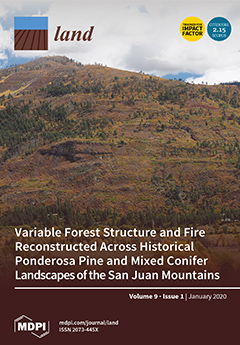Resources
Displaying 1591 - 1595 of 2258Hydrological Control of Vegetation Greenness Dynamics in Africa: A Multivariate Analysis Using Satellite Observed Soil Moisture, Terrestrial Water Storage and Precipitation
Vegetation activity in many parts of Africa is constrained by dynamics in the hydrologic cycle. Using satellite products, the relative importance of soil moisture, rainfall, and terrestrial water storage (TWS) on vegetation greenness seasonality and anomaly over Africa were assessed for the period between 2003 and 2015. The possible delayed response of vegetation to water availability was considered by including 0–6 and 12 months of the hydrological variables lagged in time prior to the vegetation greenness observations.
The Role of Vegetation in the Morphological Decoding of Lisbon (Portugal)
In the academic context, especially in the fields of architecture, landscape architecture, and urbanism, urban form studies are assumed to be a vehicle for reflection on the built and unbuilt city. This essay aims to challenge the most common and stabilized morphological approaches in the city reading process, invoking vegetation and its role as an element of urban composition that is recurrently left out of it.
Determinants of Agricultural Infrastructure Construction in China: Based on the “Participation of Beneficiary Groups” Perspective
Agricultural infrastructure is a typical public good, and it plays an important role in rural development. The “participation of beneficiary groups (PBG)” system is encouraged by government to supply village level public goods in China. Based on micro survey data from the village level in Jiangsu Province, this study analyzes the status of agricultural infrastructure construction and the promotion of PBG model and quantitatively analyzes the impact of different factors using an econometric model.
Contextualizing Landscape-Scale Forest Cover Loss in the Democratic Republic of Congo (DRC) between 2000 and 2015
Shifting cultivation has been shown to be the primary cause of land use change in the Democratic Republic of Congo (DRC). Traditionally, forested and fallow land are rotated in a slash and burn cycle that has created an agricultural mosaic, including secondary forest, known as the rural complex. This study investigates the land use context of new forest clearing (during 2000–2015) in primary forest areas outside of the established rural complex.
Assessing the Effect of Land Use Change on Surface Runoff in a Rapidly Urbanized City: A Case Study of the Central Area of Beijing
The change in land use during the process of urbanization affects surface runoff and increases flood risk in big cities. This study investigated the impact of land use change on surface runoff in Beijing’s central area during the period of rapid urbanization from 1984 to 2019. Land use maps of 1984, 1999, 2009, and 2019 were generated by image classification of Landsat images. Surface runoffs were calculated with the Soil Conservation Service curve number (SCS-CN) model. Correlation analysis was used to identify the dominant factor of land use change affecting surface runoff.


